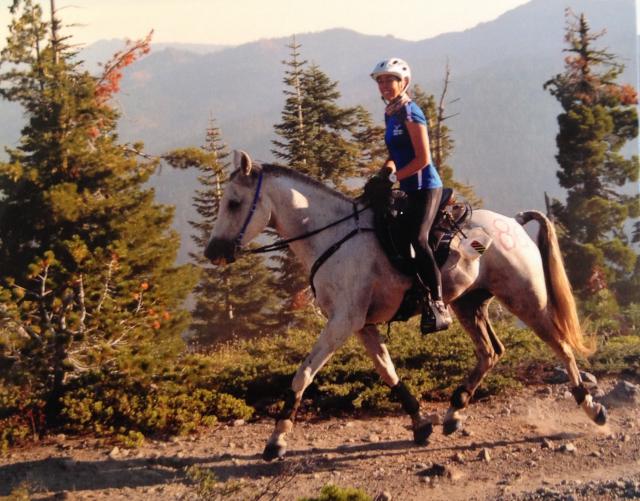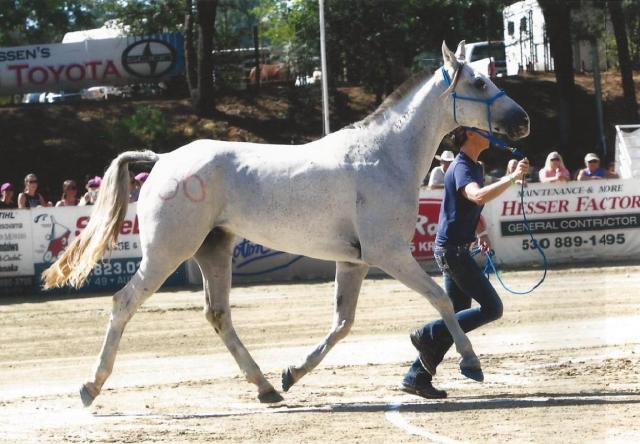Submitted by Tennessee Lane, Team Easyboot 2014 Member
Thank you, EasyCare for protecting Shazam’s feet all the way to a 2nd Place Finish at Tevis this year. Over the past month I have received more than the normal few inquiries from people wanting to know how I train, how I feed, and of course, what my hoof care regimen is. The truth is that not much has changed around my barn, I still stick to the basics. The best advice I can give is: race like you train, train like you race. With that lead-in, you might expect I’m about to write a book, but alas, I haven’t the time.

I will, however, tell you about my hoof care regimen here at Remuda Run. There is no quick way for me to answer when someone asks what I do for hoof care on a daily basis. My daily routine has a ton of variability, from roundpen work to Tevis, and more than everywhere in between. There are also multiple aspects to consider: I’ll break it down a few ways so you can decide how to make a choice in hoof protection on a daily basis. These are not rules to live by, just how I tend to do things.
There are over 30 horses under my care here at Remuda Run, all of them are barefoot. About ten of them are in the stallion/broodmare/baby category, about ten are youngsters somewhere between groundwork and saddle-breaking to preparing for their first LD’s, and about ten of them are currently competing in 50+ mile rides. Of that top ten, there are 4-5 that I could choose from on any given day to smoke a 50 or 100 miler.
Let’s consider these populations of horses A, B and C as listed. The horses in group A are pasture horses, growing babies, nursing mothers, and aging stallions. None of them are being worked, but they cover some ground in their 35-acre pasture grazing. Group B is 2 year olds up to 5 year olds, living a leisurely pasture life as well but they come up for feed twice a day, remain in a dry lot overnight, and they should get worked once or twice a week. That work can vary from very light to very strenuous, depending on how much of a fight they want to put up that day, and how far along they are in their training. Group C is 5 to 12 year olds who have been around the block, they do hard training rides at a fast pace, flats or mountain trails, and they get put on the walker 2-3 times a week barefoot on top of that, usually about 4 hours of work at a time. They spend their days cruising a 25 acre grass pasture and their nights in their own runs, they get their custom beet pulp slurry am and pm, and they expect everything on time.
Group A gets a pasture trim every 6 weeks. This trim leaves enough hoof to protect itself, a fair amount of hoofwall (at least a couple of nickels) will precede the sole and frog when touching down. I want to leave enough hoof to give them grip and natural protection but I don’t want it long enough where they are breaking their own quarters out (although it sometimes happens – they survive.) Group B gets trimmed at least every 4 weeks and touch-ups if they’re going to wear boots. This trim is tighter than a pasture trim, so they can fit into a boot without flares getting in the way. They can be ridden barefoot in most terrain if necessary without being painful. They can even handle a rocky trail ride barefoot with no problems at a walk but it would be painful at a trot. Group C gets trimmed every time they get ridden, which is at least weekly. These horses’ hooves are kept tight, a very close shave, the toes are brought all the way back to the white line for speedy and efficient break-over. The hoofwall and sole make a seamless, concave connection. These hooves will slide very snugly into Gloves and Glue-Ons a half-size smaller than the same hoof with a less tight trim. I trim and boot these horses every time I ride them.
Now let’s consider other factors. There are generally three types of rides I do: Booze Cruises: almost all walking but usually on technical mountain trails with lots of rocks; Training Rides, mostly trotting at faster pace with some stretches of cantering, and time is made for the technical spots like muddy creek crossings or technical rock ledges; and Bombers, mostly cantering, covering the ground as quickly as possible, including keeping a good pace through the technical bits. These three types of rides should have you considering three variables: speed/gait, distance, and terrain/footing, and all of these should be considered when choosing hoof protection.

For a Booze Cruise on a healthy barefoot horse that has been kept the way I keep them, I take them out barefoot or I will use Easyboot Trails, depending on the footing, either just on the fronts or all the way around. The Easyboot Trails fit the hooves whether they were just trimmed or even if they are 4 weeks out. For a training ride, I use Easyboot Gloves on the fronts or all the way around. I will likely touch up the trim for the Gloves to fit correctly and function properly. For a bomber ride, I will trim my horses hooves tight, and tape the hooves with athletic tape and put the tightest fitting Easyboot Gloves on all-around, or I will glue something on.
For endurance riding and racing, again, it depends on the terrain. There are a lot of things to consider: is it rocky, is it muddy? Are there a lot of bogs or creek crossings? I use Easyboot Gloves for most of my racing, over a fresh clean trim, sometimes with tape on the hoof wall, sometimes with Sikaflex in the sole. For multi days or anything over 50 miles I will “Goober Boot” (which I still do very frequently, in fact, my boots were “ghetto style” at the NAETC,) or I will glue-on, and any of the EasyShoes or Glue-Ons that EasyCare offers will work, but if it’s super rocky then I will definitely choose a model that will protect the entire hoof/sole/frog. The Glue-On is my favorite, but I’ve been having a lot of fun in the EasyShoe Sport lately too. When I glue, I follow the protocol that EasyCare recommends, and I use Adhere on the walls and Sikaflex in the sole.

All this said, it’s not very complicated for me to decide how to trim a hoof or what hoof boot to use but there are a lot of factors that I consider before making the decision. What is the horse’s lifestyle? What level of work is it doing? What speed will it be maintaining? What kind of terrain will it be covering? What distance? Will I touch up the trim before booting?
Scenario 1: my friend wants me to teach her how to ride. I will take two older horses to the mountain trails for an easy pleasure ride. Hoofcare? Pull the horses our of the pasture and throw Easyboot Trails on them, then have a blast.
Scenario 2: I want to go to Moab to do two 50 milers on the same horse. Moab has lots of deep sand and rock. Hoofcare? Trim them tight and tape on Gloves or Glue-Ons.
Scenario 3: my friend asks if he can take one of my horses on an elk hunt. Hoofcare? Hmmmm, he will likely walk the entire time, plus he’s not that knowledgeable about booting so I want booting to be easy for him, I’ll send him along with a full set of Easyboot Trails.
Scenario 4: I want to go do an LD at Barefoot in New Mexico. Hoofcare: Afraid to go barefoot? Wear Gloves.
Scenario 5: North American Championships / FEI 3* 100 mile race. Hoofcare? It doesn’t matter what the terrain is, the point is you’ll be galloping everything regardless. Glue-Ons.
Scenario: Tevis. Hoofcare? Are you kidding? The obvious choice is Easyboot Glue-Ons. There is no alternative.

There are a million scenarios and a lot of factors to consider. Here’s the trick: make sure you consider all the factors. If you do, the choices are easy. Easyboot.




